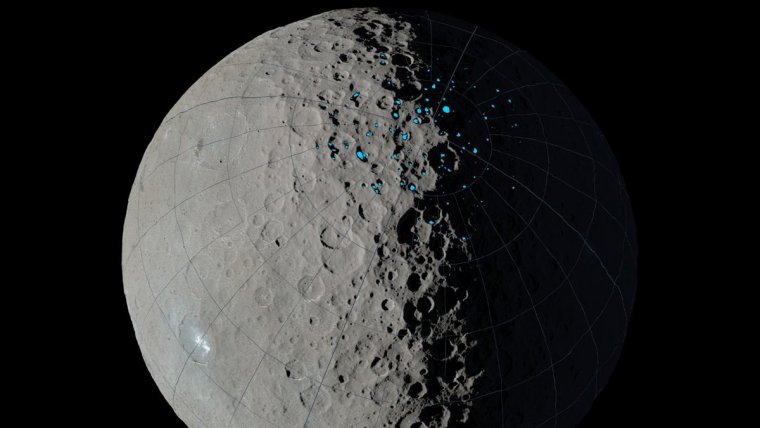| News / Science News |
Dawn Maps Ceres Craters Where Ice Can Accumulate
NASA | JULY 8, 2016
Scientists with NASA's Dawn mission have identified permanently shadowed regions on the dwarf planet Ceres. Most of these areas likely have been cold enough to trap water ice for a billion years, suggesting that ice deposits could exist there now.

At the poles of Ceres, scientists have found craters that are permanently in shadow (indicated by blue markings). Such craters are called "cold traps" if they remain below about minus 240 degrees Fahrenheit (minus 151 degrees Celsius). ![]()
Permanently shadowed regions do not receive direct sunlight. They are typically located on the crater floor or along a section of the crater wall facing toward the pole. The regions still receive indirect sunlight, but if the temperature stays below about minus 240 degrees Fahrenheit (minus 151 degrees Celsius), the permanently shadowed area is a cold trap -- a good place for water ice to accumulate and remain stable. Cold traps were predicted for Ceres but had not been identified until now.
The researchers found dozens of sizeable permanently shadowed regions across the northern hemisphere. The largest one is inside a 10-mile-wide (16-kilometer) crater located less than 40 miles (65 kilometers) from the north pole.
Taken together, Ceres' permanently shadowed regions occupy about 695 square miles (1,800 square kilometers). This is a small fraction of the landscape -- much less than 1 percent of the surface area of the northern hemisphere.
The situation on Ceres is more similar to that on Mercury than the moon. On Mercury, permanently shadowed regions account for roughly the same fraction of the northern hemisphere. The trapping efficiency -- the ability to accumulate water ice -- is also comparable.
By the team's calculations, about 1 out of every 1,000 water molecules generated on the surface of Ceres will end up in a cold trap during a year on Ceres (1,682 days). That's enough to build up thin but detectable ice deposits over 100,000 years or so.
While cold traps may provide surface deposits of water ice as have been seen at the moon and Mercury, Ceres may have been formed with a relatively greater reservoir of water. Some observations indicate Ceres may be a volatile-rich world that is not dependent on current-day external sources.
YOU MAY ALSO LIKE





